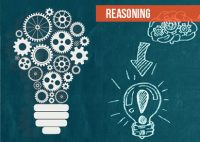Mathematical Operation For SBI PO Set – 16

Mathematical Operation For SBI PO Set – 16
1) Which of the following expressions will be true if the given expression ‘A > B ≥ C < D < E’ is definitely true?
a) A ≥ C
b) E > C
c) D ≥ B
d) A > D
e) None of these
2) In these questions, relationship between different elements is shown in the statements. These statements are followed by two conclusions.
Statement:N = P, P < F, F > L, L = K
Conclusions:
I. F = K
II. F > K
a) If only Conclusion I follows
b) If only Conclusion II follows
c) If either Conclusion I or II follows
d) If neither Conclusion I nor II follows
e) If both conclusions I and II follow.
3) In these questions, relationship between different elements is shown in the statements. These statements are followed by two conclusions.
Statement:Z > T, T < M, M < J
Conclusions:
I. T < J
II. J < Z
a) If only Conclusion I follows
b) If only Conclusion II follows
c) If either Conclusion I or II follows
d) If neither Conclusion I nor II follows
e) If both conclusions I and II follow.
4) In these questions, relationship between different elements is shown in the statements. These statements are followed by two conclusions.
Statement:Q = Z, C ≥ G, G ≥ Q, Q ≥ R
Conclusions:
I. G ≥ Z
II. C ≥ R
a) If only Conclusion I follows
b) If only Conclusion II follows
c) If either Conclusion I or II follows
d) If neither Conclusion I nor II follows
e) If both conclusions I and II follow.
5) In these questions, relationship between different elements is shown in the statements. These statements are followed by two conclusions.
Statement:K < L, K > M, M ≥ N, N > O
Conclusions:
I. O < M
II. O < K
a) If only Conclusion I follows
b) If only Conclusion II follows
c) If either Conclusion I or II follows
d) If neither Conclusion I nor II follows
e) If both conclusions I and II follow.
6) In the following questions, the symbols #, $, @, * and © are used with the following meaning as illustrated below:‘P # Q’ means ‘P is not smaller than Q
‘P $ Q’ means ‘P is neither smaller than nor greater than Q’
‘P @ Q’ means ‘P is neither greater than nor equal to Q’
‘P * Q’ means ‘P is not greater than Q’
‘P © Q’ means ‘P is neither smaller than nor equal to Q’
Now in each of the following questions assuming the given statements to be true, find which of the two conclusions I and II given below them is/are definitely true.Statements:F # G, N $ G, N © T
Conclusions:
I. T @ F
II. N * F
a) If only Conclusion I is true
b) If only Conclusion II is true
c) If either Conclusion I or II is true
d) If neither Conclusion I nor II is true
e) If both Conclusion I and II are true
7) In the questions given below, certain symbols are used with the following meaning.
A @ B means A is greater than B.
A * B means A is either greater than or equal to B.
A # B means A is equal to B.
A $ B means A is either smaller than or equal to B
A + B means A is smaller than B
Now in each of the following questions assuming the given statements to be true, find which of the two conclusions I and II given below them is / are definitely True?
Statements:
D + T; E $ V; F * T; E @ D
Conclusions:
I. D $ V
II. D + F
a) if only conclusion I is true
b) if only conclusion II is true
c) if either conclusion I or II is true
d) if neither conclusion I nor II is true.
e) if both conclusions I and II are true.
8) If P denotes +, Q denotes – , R denotes × and S denotes ÷, then which of the following statements is correct?
a) 16 R 12 P 49 S 7 Q 9 = 200
b) 32 S 8 R 9 = 160 Q 12 R 12
c) 8 R 8 P 8 S 8 Q 8 = 57
d) 36 R 4 S 8 Q 7 P 4 = 10
e) None of these
9) Which one of the four interchanges in signs and numbers would make the given equation correct?
3 + 5 – 2 = 4
a) + as −, 2 as 3
b) + as −, 2 as 5
c) + as −, 3 as 5
d) All of these
e) None of these
10) In the following questions, the symbols @, #, $, %, * are used with the following meanings as illustrated below:
‘A @ B’ means ‘A is not greater than B’;
‘A # B’ means ‘A is greater than or equal to B’;
‘A $ B’ means ‘A is neither greater than nor less than B’;
‘A % B’ means ‘A is less than B’;
‘A * B’ means ‘A is neither less than nor equal to B’.
Now, in each of the following questions, assuming the given statements to be true, find which of the three conclusions I, II and III given below them is / are definitely true.
Statements:T # R, R % L, L * K
Conclusions:
I. T % L
II. K * R
III. T # K
a) Only I is true
b) Only I and II are true
c) All are true
d) Only II and III are true
e) None of these


